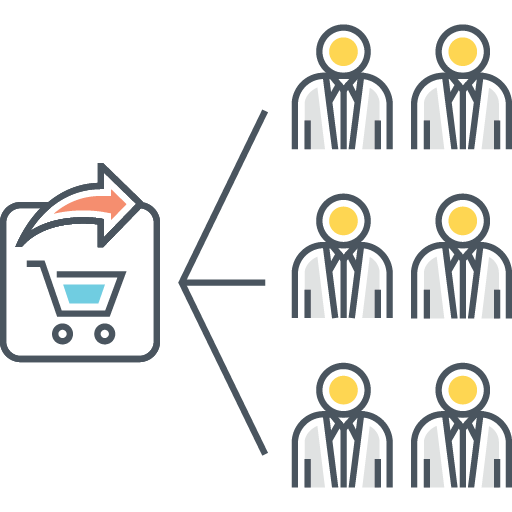How To Increase Profit On Your Membership Site
If you're drowning in day to day tasks like most membership site owners, it feels impossible to take the time to work on areas of your business that actually result in tangible, long term improvements. We have so many redundant tasks to perform just to stay afloat: emails, support tickets, marketing management, people management, content creation, website upkeep, the books, community curation, and on and on and on and on.
We often get caught in the trap of spending 100% of our time working in our business rather than on our business. You are the founder and CEO, but at the end of the day, you're also the proverbial CTC (Chief Toilet Cleaner). And for some crazy reason, the toilet often gets the most attention. That's backwards. If the toilet is clean but the house it's sitting in crumbles around it, what the crap does it matter?
Taking the time necessary to set goals and priorities and work backwards from there to create a path to achieve them is your job as CEO – take it seriously and create space for it. The ways you spend your time on a day to day basis should revolve around the goals you set when you have your CEO hat on.
I'm going to show you how to start exercising your RGA muscles and get in the habit of ruthlessly prioritizing improving areas of your business that lead to money in the door, and more importantly, higher profit.
This 3 part series is going to cover what those revenue generating activities are, then how to prioritize and actually do them.
Before we get started, let's put RGAs into 3 categories for membership sites specifically:
- Increasing profit
- Increasing efficiency: Systems creation and implementation
- Decreasing expenses: Auditing your expenses
We'll cover increasing the efficiency of your business and decreasing your expenses in parts 2 & 3 of this series. The focus of this article is all about the first RGA: increasing profit.

Part 1: How to Increase Profit
There are 3 primary means by which to increase the profitability of your membership site:
- Decreasing Churn
- Increasing Lifetime Customer Value (LCV)
- Getting more Members
Let's break them down:
Decreasing churn
Harvard Business Review tells us that your profitability will increase by 25-95% if you're able to reduce your churn by just 5%.
Here are 3 key approaches to reducing churn:
- First up is tackling involuntary churn, also known as credit card churn.
- The second is decreasing engagement related or voluntary churn.
- And the third approach is to run a quick audit of your marketing messaging, deliverables to your paying members & community engagement, and running surveys.
Let's dig into these one by one:
Involuntary Churn
Involuntary churn happens when something regarding a member’s credit card changes and your payment processor is unable to auto charge their card when their regular payment is due.
Churnbuster and Profitwell’s Retain product are the top ready-made solutions to prevent the majority of involuntary churn. On the surface they may seem expensive, but I’ve not ever seen a case in which a membership site actually lost money using one of these tools.
All MemberMouse plans also include an automatic overdue payment handling feature which will automatically attempt to rebill your member a total of 3 times once their account goes into overdue status.
If you don't have access to any of these tools, the least you can do here is have your email provider kick off an automated email sequence that notifies your member of their failed payment and offers the easiest path possible to re-enter their credit card info for continued access.
You can eliminate a significant portion of your churn by implementing automated systems for recovering failed payments. This is a no-brainer for anyone running a membership site as a business, not just a hobby.
Voluntary Churn
Voluntary churn happens after you bring on a qualified member, ripe for achieving power user status, but they become unengaged over time, and eventually cancel.
It’s best to nip this in the bud before it happens by tracking engagement and intervening to bring that member who is slipping away back to active engagement and receiving value on your site before it’s too late.
Until now, monitoring member engagement has been a tedious process involving lots of late nights and spreadsheets. And if you haven’t been doing that, you’ve left untold amounts of money on the table as those who have become unengaged over time have churned, and you don’t have any further recourse.
That's why tools like MemberMouse's member activity log are so helpful. When you have an easy way to identify which of your members are at risk of canceling their accounts due to disengagement, you can swiftly intervene and attempt to retain them as a customer.
What's important is that you know who is starting to slip away and intervene with a re-engagement email sequence to nurture that member back into active participation on your site. Your members signed up for your site expecting to receive a certain type and level of value – it's your job to make sure they get it! Otherwise, you're missing out on the benefits akin to compound interest and you'll stay on the hamster wheel of churn as long as your membership is around.
Run an Audit
Lastly, you need to run audits of your marketing, membership product, and make sure you're periodically getting valuable feedback from your existing members.
Marketing and selling to the right members in the first place is vital to decreasing churn and thereby increasing lifetime customer value and profit. All marketing efforts should be directed to those who resemble your power users and will therefore stick around your site longer than those who weren’t the best fit for your membership offering in the first place. I define a power user as your most engaged, highest LCV, membership evangelists.
You must understand the features and benefits that your membership provides to those power users, then tout those the most prominently in your marketing messaging. In taking that approach, you'll likely naturally attract people with a similar profile to your existing power users. Once you bring on a new member that has the potential to reach power user status, you need to onboard them in a way that pushes them along the same feature adoption path your powers users took when they first joined your membership.
Next up, you need to assess your product delivery and community engagement. Are you delivering the content, benefits, etc. that you promise in your membership marketing? Are you consistently providing value to your members? How do you stack up to your competition? Are you curating your community (if you have one) in a way that encourages participation, collaboration, and member success? Are a large subset of your members engaged in your community, and if not, what are you going to do about it? What kind of organic feedback are you receiving from current and prospective members?
Once you ask yourself those questions, you need to ask your members what they think. Two types of surveys should be conducted on your site: exit and current customer.
When a member cancels, that’s your best opportunity to ask them why they’re leaving. Not everyone will answer, and not every answer will be useful. That’s ok. The goal is to gather enough responses that in aggregate, they surface some useful information. Set up an exit survey through your email provider that gets kicked off when someone cancels and pay attention to the responses you get.
Second, ask segments of your current members what they like most and least about your site. Invite any other feedback as well. There are a number of survey tools out there, but if you're only asking a few hundred people, just sending out an email with 3 questions is the path of least resistance.
In your RGA planning sessions – the time you set aside regularly for CEO level strategizing and planning – take a hard look at the feedback you receive and take action based on what your paying members really want, need, an expect from you.

Increasing Lifetime Customer Value
There are two primary ways to increase the amount a member pays you over the lifetime of their membership.
- Decrease your voluntary and involuntary churn, addressed above
- Upsell your members on additional products and/or services
What do I mean by upselling? I'm referring to selling existing members something in addition to whatever they're currently paying you for. That could be a more expensive membership subscription, or some kind of one-off purchase like an ebook, course, or service.
For every upsell you offer, it's imperative to offer the right upsell to the right member at the right time. Meaning, you need to know who your most and least engaged members are so you're not asking someone who desperately needs TLC to buy something else from you! If you're a MemberMouse user, you can create powerful, perfectly-targeted upsell offers to your members with SmartTags.
The absolute easiest thing to offer as an upsell is an annual subscription. Annual subscribers have a far lower churn rate than those on monthly plans across the board with memberships, subscriptions, and SaaS businesses.
Annual plans can be especially profitable if your lifetime customer value is lower than the price of an annual plan. For example, if your average LCV is $400 (8 months at $50/month), then selling an annual plan for $500 (12 months for the price of 10) is a smart move, and that's even before considering any renewals. Annual plans give you the opportunity to help you help your members receive more value from your membership product.
If you have the means to provide more value to a critical mass of your members, you could create a higher priced membership tier. That tier might include things like an exclusive discussion forum, special badges or recognition, access to additional content and perhaps increased access to you if you're functioning as the subject matter expert on your site.
Standalone products such as ebooks, online masterclasses, special courses, and swag are just a few examples of offerings you can make to your members to increase their LCV. These standalone products could also be offered to your prospects as a way to position yourself as an authority in your industry space and get them used to spending money with you.
Standalone services like one-on-one or group coaching and critiques of work related to your membership are awesome offerings if you have the demand from your members and the staff bandwidth necessary to execute them well.
If all of this sounds good in theory, but like a major technological headache, leverage the tools built in to your current tech stack to streamline upsells, keep track of KPIs, etc. Use MemberMouse's Reporting Suite to track your churn rate, lifetime customer value, product sales, and more. MemberMouse also makes upselling a breeze with their 1-Click Purchase Links, aka 1-click upsells.

Getting more members
Probably the most obvious way of all to increase your site's profitability is to bring more members on to your site. However, determining the best marketing mix for your membership site can feel like an insurmountable feat – especially if marketing and sales aren't in your wheelhouse.
As a marketer, you have a world of possibilities when it comes to where and how you market your membership. In the long run, it's mission critical for you to find the 2-4 most viable marketing channels for your membership.
Viable acquisition channels are both profitable (your CaC -Customer Acquisition Cost – MUST be lower than your LCV or you're dead in the water) and reliable (provides a steady stream of leads rather than it worked once but never again).
Here's how to determine the most viable acquisition channels for your membership:
- Pick a channel (a place to market or advertise)
- Conduct a test
- Assess your results to see which channels are in fact most viable
- Repeat until you find the 2-4 most viable channels that will help you scale
Back to science class for a sec…
Just like elementary school science, your test should have a hypothesis, defined parameters, and a way to assess your results. So, first, make an educated guess on what results you should expect from your marketing test. Second, define the scope of the test. For our purposes that can just include timeline and budget. Lastly, make sure you are able to assess success metrics when the test is complete.
A do or die litmus test for a marketing acquisition channel, is “can I assess my results when this thing is done, or is this a shot in the dark?” If it's a shot in the dark, there are very few scenarios in which you should proceed.
If you pay more for customers than they pay your membership business, you will go bankrupt. The only way to know this is if you run tests with a predetermined budget, timeline, and then assess your results.
Acquisition channels must be both profitable and reliable, and you won't know what those are unless you run the numbers. While this is at times soul-sucking work, it's foundational to having even moderate success, and absolutely imperative for scaling your membership.
I hope you enjoyed this post. Stay tuned to the MemberMouse Blog for part 2: Increasing the Efficiency of Your Membership Site.
Amanda Northcutt
Amanda is a revenue strategy consultant for online businesses with recurring revenue models. She lives in Fort Collins, CO and spends her free time with her family, cycling, hiking, and pretty much any mountain sport under the sun.
 Blog
Blog Podcast
Podcast Support
Support Customer Login
Customer Login









